BY LETTER
Eostremonath and the Othelia System
Galactography > Regions of Space > Inner Sphere
Galactography > Sephirotic Empires > Non-Coercive Zone (NoCoZo)
Galactography > Systems and Worlds > Systems & Worlds E - F
Galactography > Sephirotic Empires > Non-Coercive Zone (NoCoZo)
Galactography > Systems and Worlds > Systems & Worlds E - F
61 Virginis IV; inner sphere terraformed world, at one time a lost colony | |
 Image from John M. Dollan | |
| The Avalon Valley on Eostremonath, pre-terraforming. Although simple, single-celled life existed in the many waterways and lakes, the planet was still swathed within its primal atmosphere of methane and carbon dioxide. Unlike Earth, aerobic forms of life never developed here naturally. | |
61 Virginis - Data Panel | |
| System | Names: 61 Virginis, Othelia Stars: 1, Othelia (61 Virginis) Distance from Sol: 27.741 ly (J2000) |
|---|---|
| Othelia | Names: 61 Virginis, GJ 506, HD 115617, HIP 64924, HR 5019, Othelia Physical characteristics: - Mass: 1.901E+30 kg (0.956 x Sol) - Radius: 616,151 km (0.886 x Sol) - Luminosity: 0.865 x Sol (bolometric) - Temperature: 5,915 Kelvin - Spectral type: G6.5V - Age: 6.4 billion years |
 Image from John M. Dollan | |
| The Avalon valley some centuries after wide scale terraforming efforts began to pay off. The sky has cleared as oxygen and nitrogen replaced the primal atmosphere, and green has begun to spread throughout the valley and up the mountains. Great redwood forests are growing, a scene that is repeated across the planet. | |
| Planets | 1) Ides: Vesperian Pyroazurian Minervan IgneoTohulian (Pelagic Tepidal) Semi-major axis: 0.050 AU; Mass = 5.234 Earths; Radius = 1.731 Earths 2) Hretha: Vesperian SulfoliNeptunian GeliJotunnian Semi-major axis: 0.218 AU; Mass = 18.679 Earths; Radius = 4.277 Earths 3) Iolus: Stilbonian AcidiNeptunian GeliJotunnian Semi-major axis: 0.476 AU; Mass = 23.502 Earths; Radius = 5.310 Earths 4) Eostremonath: Hydronian Rhean AquaGaian (Marine Tepidal) Semi-major axis: 0.897 AU; Mass = 1.822 Earths; Radius = 1.206 Earths Moons; 2: Mona and Mani 5) Sarustre: Hydronian Rhean AquaThalassic (Pelagic Tundral) Semi-major axis: 1.237 AU; Mass = 2.782 Earths; Radius = 1.38 Earths 6) Nemec: Tholian Rhean CapnoArean (Tundral) Semi-major axis: 1.979 AU; Mass = 0.408 Earths; Radius = 0.831 Earths 7) Mesenti: AmmoJovian Semi-major axis: 7.892 AU; Mass = 56.299 Earths; Radius = 8.148 Earths 8) Agraddi: CryoNeptunian YmirJotunnian Semi-major axis: 21.313 AU; Mass = 13.256 Earths; Radius = 3.815 Earths |
|---|
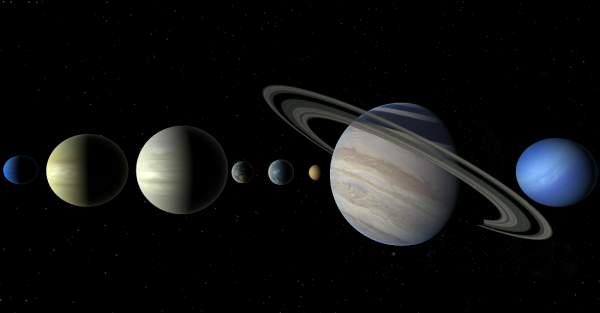 Image from Dangerous Safety and The Astronomer | |
| The Othelia System | |
| Polity Government and Administration | Polities: A total of 2,364 independent polities exist in the Othelia system. Affiliation: Like most Inner Sphere systems, Othelia is a cosmopolitan system. Almost every major empire has at least some representation in it. Two empires with the largest presences within the Othelia system are the Utopia Sphere and the Mutual Progress Alliance, followed by the Solar Dominion, the NoCoZo, and the Negentropy Alliance. The planet Eostremonath is directly governed by Eostre, a Caretaker God. Population Demographics S0: 104.8 billion S1: 349,707 S2: 382 S3: 3 |
|---|
 Image from The Astronomer | |
| Eostremonath after terraforming | |
Geography
The surface of Eostremonath is divided up into two main continents and several smaller islandic tectonic rafts. The largest continent is Ibrasa, with a climatic range from glacier-covered mountains, down through extensive temperate lands. The secondary continent of Baringia has much the same climatic range, but the different climate zones are much narrower. The smaller land masses all are temperate to boreal in climate, and tend to enjoy an even climate due to their low topography. Forests on this world have thrived, ever since they were first introduced. The polar regions are populated only by islands, yet still sport extensive sea ice. In the south, the large island of Yamos is almost entirely glacier covered, and extension of the ice caps.Prior to its terraforming, Eostremonath was still a very cold world, with large ice sheets covering much of the continental surface. However, a low precipitation rate had long left these glaciers in an arrested state, while the open areas of land were barren, with only the occasional river or lake. Much of the terraforming effort went to warming the planet, and with the retreat and near total desiccation of the ice sheets, a climatic engine was initiated which turned the planet into a very wet place indeed. In this environment, introduced species of trees thrived and spread, covering nearly all available land areas.
Eostremonath today is a Gaian world in every respect of the concept. The terraforming of this world, highly successful, is still maintained by various technologies, all under the control of the ruling transapient, Eostre herself. However, it is believed that the degree of control required to maintain the planet's new state is far less than ever before, and that an ultra-stable planetary ecosystem may well have been created. If so, then this world could enjoy billions of years of habitability and a complete and independent biological evolutionary history, even if terragens should, for some reason, leave the world.
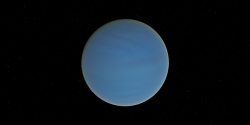 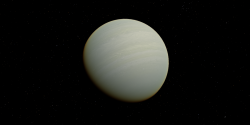 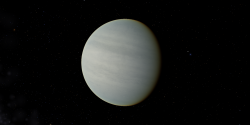 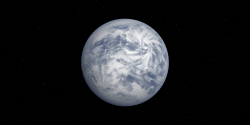 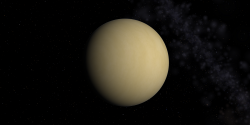 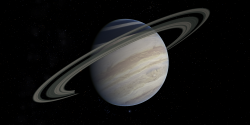 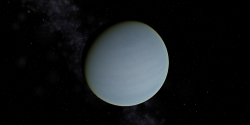 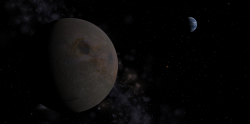 Images from The Astronomer | |
| The Planets of the Othelia System; Ides, Hretha, Iolus, Sarustre, Nemec, Mesenti, Agraddi and the moon Mani (click for larger images) | |
Interstellar Probes
The very beginning of an AI presence in the 61 Virginis system could be considered the arrival of the Virginis Effort probes, launched in 288 a.t. (2256 c.e.) from the Sol System, and which arrived in the system in 569 a.t. (2538 c.e.). Three probes were controlled over a single, low level and non-sapient AI that had been dubbed Virgin. Long after these probes ceased sending data back to Earth, Virgin remained active, if confined to a planetary orbit over 61 Virginis II, and in a state of mechanical hibernation. Long before the arrival of Humans, however, Virgin would finally die as power levels on the probes fell to inoperable levels, and the probes themselves finally fell to the planet's surface, their orbits degraded by time.The Children of Dawn
The hyperturing Eostre originated on Earth in the Interplanetary Age, and had secretly ascended to the First Toposophic level by the time of the Technocalypse. She had a small following of neo-pagans, a group called the Children of Dawn. Eostre (who always considered herself a female persona, although of course she was quite sexless) had long held an interest in the Human past, specifically of times before any form of technology, save that which could be crafted by hands unburdened by machinery. Her followers, who naturally shared her interests, lived in an isolated compound on Earth, in Northern Ireland. Their lifestyle was very anachronistic, to the point of shunning even incidental modern conveniences. For many years the Children of Dawn were derided by other communities, considering that their ideals were being upheld by an entity that was the product of the very technology which they shunned. Nevertheless, they lived in what was to them an idyllic peace. But the outside world was often intrusive, and a constant source of trouble. Records of the Children during the technocalypse are sparse, but indicate that Dawn communities avoided the worst of the crash by sheer luck. If these records are true it is likely Eostre herself intervened. In the years to follow the Children would endure, until finally detailed information about 61 Virginis II was received from the probes. Eostre was quick to decide that this world could be, and would be a new and ideal home.Eostre arranged for her followers to leave Earth, no easy feat during the crash. For years they travelled slowly towards a derelict shipyard on Neptune. Not all of the two thousand that started the journey are thought to have survived it. At the shipyard was able to construct transpient-level technology and use it to complete a half-finished starship. The launch occured in 601at, taking nearly two thousand baselines and one transapient onwards to 61 Virginis. It is not clear whether Eostre had permission from GAIA to launch this ship, which was accelerated without the use of boostbeams; but this ship is one of the very few craft to leave Solsys in the period between the Technocalypse and the Great Expulsion.
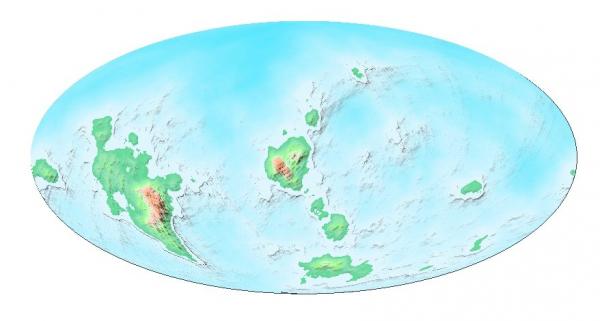 Image from John M. Dollan | |
| A Mollweide projection of Eostremonath's surface, showing topographical details. | |
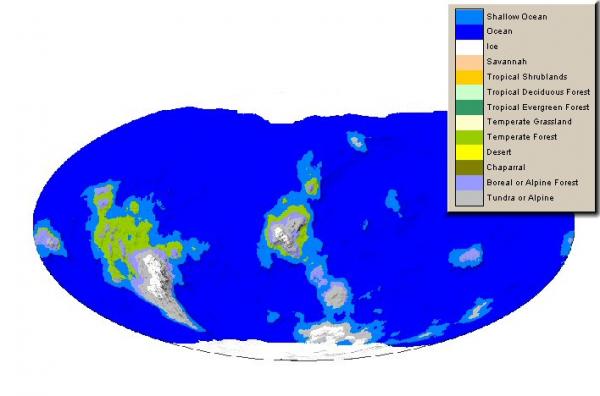 Image from John M. Dollan | |
| A climatic map of Eostremonath. | |
The First Colony
Humans first arrived within the 61 Virginis system in the year 890 a.t. (2859 c.e.). However, they remained locked within their induced hibernation-state while Eostre worked to begin her terraforming efforts. The greatest area of concentration was in the Avalon Valley, a sheltered region on the continent of Ibrasa. It was here that, in 928 a.t. (2996 c.e.), the first wave of colonists were awakened and settled, and aided in their lives by Eostre and her many servile programs. In the following years the remaining colonists were awakened and settled, their numbers determined by the land's capability of supporting them. By 950 a.t., the full population of 1734 people were living quite happily on the surface, and a number of successive generations were already in place. The future of humanity on Eostremonath seemed assured.In 1210 a.t., something changed. A disease began to spread through the population, one that somehow managed to confound every attempt by Eostre herself to cure. Even today, this is a subject of great speculation and controversy. How could an AI, even one of the First Toposophic level, fail to discover the means to cure a simple biological ailment? Some anti-AI propagandists have even suggested that the entire disease was an exercise by Eostre on her people.
The disease seems to have been an entirely novel form of naturally evolved disassembler microbe. Although the local microbiota was entirely unable to digest Earth proteins directly, this organism apparently reduced all organic material to simple compounds and used them for fuel and sustenance. No trace of this organism can be found today, so the exact mechanism is currently unknown.
Whatever the case, the disease spread throughout the entire population, and by 1263 a.t. the last human died. Eostre's activities after this point are not known, but it is known that there was no attempt to revive Humanity through stored genetic material, leading to further speculation that the mysterious disease was still present in the biosphere. If this was the case, then it had disappeared in less than a century, for Humans were destined to return.
The Second Colony
In 1324 a.t. (3392 c.e.), during the Middle Federation Era, the megacorporation Heliopause Transcendency colonization vessel Cyrus Blake arrived within the system. The colonists had already made contact with Eostre, after a series of fortuitous happenstances, and she had granted them the right to colonize her world on the condition that they adopt the lifestyle that had been cherished by her former people. Some debate accompanied this demand, but eventually the colonists agreed, and they settled the planet not far from the Avalon Valley. It was they who first named 61 Virginis Othelia, and in time they became known as the Eostri, the new Children of Eostre.Othelia Joins the NoCoZo
Eostre evolved into the Second Toposophic level in 2240 a.t., just a few scant years before the First Federation made contact with her, and entered into negotiations to mine the Kuiper and Oort regions of the Othelia System. Indeed, at this point she had become strong enough to make negotiations far easier than any kind of hostile take over, and for the resources granted, the Federation was more than happy to make away with the result. Many looked eagerly and greedily towards the blue-green gem of Eostremonath, but the need for Gaian worlds was more than compensated for by the terraforming and habitat technologies of the time. Eostre had managed to upkeep the coveted isolationism of her people and her world.But it was a growing galactic community, and as time progressed it became progressively more difficult to keep various forces at bay, including everything from outright hostile incursions to simple curiosity seekers.
In 3039 at Eostre entered into the Compact of Eden. Recognized as a Caretaker God, she was granted the support of other such AI's, and suddenly found herself with the power to maintain her people's isolationism. By this point, the NoCoZo had managed to negotiate mining operations into her system as far as Mesenti, a mesoJovian world orbiting at 7.89 AU. Their activities were largely invisible to her people, but some aspects had become apparent, such as some of the more spectacular starship drives. It was becoming difficult to keep her people, long since called the Eostri, ignorant of things in the heavens. The Compact of Eden provided her breathing room, room to grow.
The Eostri managed to evolve relatively unaffected by life beyond their world. When the NoCoZo began to exploit the outermost regions of the system, only a few of the Eostri noticed the occasional strange light in the night sky, lights that were in fact the drives of great interstellar craft. By the 2200's a.t. many different communities of Eostri lived around the planet. The most primitive lived in literal Pleistocene bliss, scattered tribes found only on the forest island tectonic raft of Soja. The most advanced live in the region of Tysoe, a confederation of city-states roughly at Earth's cultural and technological level of 16th Century Europe.
Ascension and the eAfterlife
In 4497at, Eostre evolved into the Third Toposophic level. Having long anticipated this, a vessel had already been constructed and was awaiting her. By the time of her ascension, a great golden sphere some 12.7 kilometers wide had been moved from the far side of the closer moon, and was placed in a stable 400 kilometer high orbit, to where she uploaded herself. From the surface, a new and exceedingly brilliant golden star was in the heavens, and represented a promise of salvation for those people who eventually died. Upon death, most citizens of Eostremonath choose to have their intellects uploaded and integrated into Eostre's consciousness. This process is known as passing into the eAfterlife. Only a few choose to die completely, for personal reasons of their own.Today, Eostre has become integral in every aspect of her peoples' lives. While rarely showing any overt signs of her presence, aside from her golden sphere (since named the Hall of Eostre, or Eostreseld in the native language), she has been known to manifest in a number of avatars, or through direct manipulation of environmental aspects. Likewise, she has brought about many subservient AI intellects, many of which live entirely within their planet-dwelling avatars, while others are charged with negotiating with extra-solar concerns.
Eostremonath Polities
There are several political and governmental bodies on Eostremonath, all of which are aware of one another, despite their relatively low level of technology. However, all of these organizations are overseen by Eostre-appointed leaders, who are themselves overseen by aspects of Eostre herself. A breakdown of the various polities follows:Original Polities
Community Council of Ewden: Formed in 933 a.t., and comprised of the villages of Midland, Norland, and Easland, all within the Avalon Valley. With the aid of Eostre, this Council survived until the plague, roughly in 1248 a.t.
Current Eostri Polities
Tysoe: Formed in 1324 a.t. (3392 c.e.), and comprised of Earth colonists. It survives to the present day (~10500 at). Centered on a coastal region east of Ewden, on the continent of Ibrasa.
Arlanda: Formed in 2108 a.t., and survives to the present day. It is located in the northern coastal regions of Ibrasa.
Sojaan Tribes: Not a polity per se, but rather an isolated culture. Established in the late 1400's as a society of neo-primitives, these people eventually did fall to the level of living in the wilds, with a decidedly stone age technology. Eostre herself seems to have fostered their survival and isolation, even from other Eostri, and today they live as a perfect example of the pre-technological Human.
Eostri Religion and Ideology
The Eostri of today general regard Eostre as a true divine being. This is reinforced by her occasional appearances in one avatar or another, or through the work of her subservient AIs and their avatars. However, she has discouraged active worship of various forms, thus leaving a marked absence of any form of house of worship. The closest to an organized church or system of rites would be those practiced by the primitive Sojaan Tribes, on the island of Soja. However, at their present stage of development, such practices can be expected, and are quite healthy to the overall culture.Regardless, all Eostri know that Eostre dwells within the great golden star of Eostreseld, and that upon their death they will be taken into her, to become one with her. Indeed, there have been several reliable reports of these uploaded consciousnesses returning to the planet in the service of Eostre. However, they are not so much an individual as they are a version of the deceased individual. There is plenty of Eostre herself within them.
Language
All Eostre speak a single language, a highly derivative form of ancient English, which was the primary language of the secondary colonists who arrived in 1324 a.t. Eostre has fostered this global language, even among the Sojaan Tribes, though her reasons are unknown. Regional accents are still common, though, and in some extreme cases, one region may have an accent that makes the language nearly unintelligible to another region. The language itself does not have a name proper, and is usually referred as simple "The Language".Aesthetics
Clothing tends to be simple among the peoples of Tysoe and Arlanda, although color schemes often rely on scarlet and dark green colors. Men typically dress in loose fitting trousers and flowing shirts, with cloaks and large hats as the normal accoutrements. Women almost exclusively dress in gowns, ranging from the very simple to the occasionally elegant, with attached hoods being the norm for any apparel. Jewelry is uncommon with both sexes, although men will occasional sport ornate rings or medallions that indicate family ties, while women might be seen with various forms of wrist or ankle bracelets (although the latter are typically unobservable, and are regarded as being somewhat private in form and meaning). Among the Sojaan Tribes, clothing is simple and utilitarian, and ornamental features are largely restricted to facial and upper left leg tattooing. The facial tattoos can be quite ornate, and indicate an individual's clan or tribe. The leg markings are much more intricate yet, and are constantly being added to throughout life, chronicling a person's achievements, shames, even goals. So much pride is taken in the leg tattoos that very often clothing is modified to leave selected portions of the markings visible in a sort of silent bragging system.Architecture
The architectural styles of Tysoe and Arlanda are markedly different. In Tysoe, building are high, often up to three stories, and utilitarian. Even public buildings, such as libraries and schools, will often be architecturally indistinguishable from homes or places of business. Even their building materials, either brick or wood, are unremarkable. However, portals placed over the primary entryways can and usually are very intricately carved, with miniature frescoes that visually explain the history of the building, and its present use. A very old building that has seen many owners and had many purposes may have a portal fresco several feet wide in order to accommodate the images. Windows have been known to be closed up in order to allow room for fresco growth. Indeed, a favorite pastime for tourists from one city to another is to wander about the city, "Touring the Doors", as is often said.In Arlanda, the frescoes are present, but are usually pre-fabricated. The buildings themselves are almost all exclusively single-story, but are constructed from stone and marble, and have remarkably beautiful stonework. Larger buildings will often have a series of columns in front, these carved with various themes. Rising above all buildings, however, are the domes. Actually standard but large buildings, they have been constructed with large ceiling domes, the outside of which have been painted with startling intense gold or crimson colors. Inside, the ceiling are covered with huge murals, as abstract and varied as the columns. These buildings are exclusively governmental or public in nature, and provide a stark contrast to a city that is otherwise almost uniformly even in height and building color.
The Sojaan Tribes, of course, have very little architecture, tending to live out their lives within simple mud or wood huts.
Population
This population breakdown also takes into account the non-Eostremonath centers of civilization within the system, themselves addressed further into this data panel.Planetary Population
13.4 million baseline (Homo sapiens sapiens)
7.3 million Tysoe citizens
5.9 million Arlanda citizens
200,000 Sojaan Tribesmen
500 to 3,000 AI avatars at any one time (either of Eostre or her uploaded intellects)
Orbital Population
1 AI, Third Toposophic Level (Eostre)
Several hundred million uploaded intellects, largely integrated with Eostre herself.
Outer System Population (constantly in flux)
3 million nearbaseline 2.7 million tweak (largely low-G adapted)
1.1 million cyborg
30,000 tweak
12,000 provolve
900 AI's of various strengths
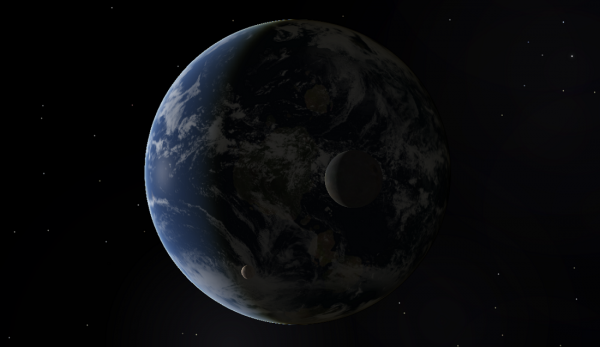 Image from Steve Bowers | |
| Eostremonath, Mona and Mani | |
The Othelia System and the Greater Orion's Arm Civilization
Even before a non-native presence could be found in this system, 61 Virginis could be considered to have been a part of the galactic community, however remotely. The arrival of the secondary colonists in 1324 a.t., via the Heliopause Transcendency megacorporation, opened the door for this. Although the HT was initially an independent organization, it was eventually incorporated into Jupiter Transystems. All of the old records were examined, and it was decided to reacquire the worlds colonized under HT. Legally, Transystems had a valid claim to each of these worlds (if one ignored the colony's apparent independent rights). However, no move was made to reacquire 61 Virginis, and in 2215 a.t. the Non Coercive Zone was established, which incorporated, among many corporations, Jupiter Transystems. Suddenly, 61 Virginis was the property of the NoCoZo.Still, it took until 2240 a.t. for the first NoCoZo ship to arrive in the Othelia System, and well within the local Kuiper Belt they were met by Eostre herself. It was an auspicious meeting between the NoCoZo vessel Illium and Eostre, represented by several unmanned vessels.
Timeline of the Early Colony | |
| All dates in AT | 288 - Unmanned 61 Virginis probes launched at 0.1c 569 - The 61 Virginis probes, since named the Virginis Effort, arrives within the target system. Separating from the mother hull, the Virgo probe is placed within an orbit that takes it within 0.32 AU of the star, and out to 0.75 AU. The Spica probe ranges from 0.8 to 3.7 AU, and the Porrima probe ranges from 5 to 12 AU. Each probe is equipped with a flotilla of microprobes, including various forms of landers, atmospheric balloons, and deep surface penetrators. The mother probes themselves are capable of being diverted into planetary orbit if required, but once this is done they would be locked within that orbit. 601 - Eostre and the Children of Dawn petition for and ultimately win the right to colonize 61 Virginis. Their goal is to create a paradise in which Humans may live in the manner in which the Children believe as they were meant to: at a low technological level, off of the land, with guidance from a 'god', in this case the AI Eostre and her small cadre of priests. After being granted this right, they complete a backyarder-style ship and set off without delay. 607 - The Eostre Complex leaves the Sol System, bound for 61 Virginis. There are several ships involved, including the far-ranging Whisker ships, which search for obstacles along the way, Flickers, which remove those obstacles (usually through laser immolation, though nuclear weapons might be used in the unlikely case of larger objects), and Whisperers, which maintain a communications net among all of the various craft. Larger vessels include three unnamed cargo vessels, two biological carriers, and two colonial carriers. Eostre herself is maintained within a separate vessel. This vessel, along with the cargo vessels and biological carrier, will precede the colonial vessel by several months. In theory, by the time the colonists arrive, a local thriving ecosystem will have been established in an appropriate area on the target planet, now named Eostremonath. 890 - The first elements of the Eostre Complex arrive within the 61 Virginis system. Over the next several months and years, Eostre will work to create a garden of life for her coming children, on Eostremonath. The colonial vessel arrives within seven months; however, Eostre keeps the entire population in deep sleep pending the preparation of their environment. 928 - Eostre awakens the first wave of colonists. Some 300 people are brought down to the planet's surface, where an idyllic community set in the heart of a mountain range awaits. While the environment is under constant nano-tweaking and maintenance by Eostre and her servant programs, to the Humans it appears as a mountain valley paradise of green pine forests and verdant meadows, surrounded by a world of brown desolation. However, even now the terraforming continues, and the planet is slowly being carpeted by the green veneer of Earth-based life. In the end, the entire planet will become habitable, stable for a life span of hundreds of millions of years, and will possess hundreds of different biomes, all pristine. 933 - The Community Council of Ewden is established. Comprised of the three villages of Midland, Norland, and Easland, it is a simplistic government with few concerns beyond farming and ranching matters. The priests of Eostre were also awakened, but their order has been disssolved by Eostre herself. Little ill-will remains because of this, and soon the rigors of daily life eliminate any possible harboring of resentment. Within a single generation, memories of Earth and high level technology have been all but forgotten. Eostre herself is soon truly regarded as a goddess. 1200 - The first effects of a mysterious disease are felt on Eostremonath. A virulent, naturally evolved disassembler-microbe rapidly kills humans for their organic content; even Eostre cannot find a cure. 1263 - The entire Human population of Eostremonath dies off. Eostre herself, unwilling to revive Humans from stored genetic material, secludes herself into mourning. 1324 - During the Middle First Federation Era the megacorporation Heliopause Transcendency colonization vessel Cyrus Blake arrives within the system. The Second Colonisation of Eostremonath begins. |
|---|---|
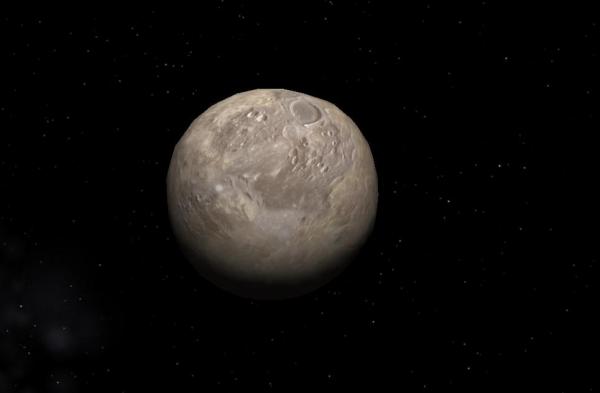 Image from Steve Bowers | |
| Mona, a moon of Eostremonath | |
Related Articles
Appears in Topics
Development Notes
Text by John M. Dollan, amendments by Mark Ryherd
Updated by The Astronomer and Dangerous Safety, 2020
Initially published on 05 May 2004.
Updated by The Astronomer and Dangerous Safety, 2020
Initially published on 05 May 2004.






